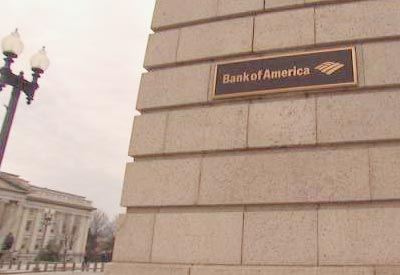
Ken Lewis, the CEO of Bank of America, is in trouble: a stock collapse; a rocky merger; the worst fourth-quarter losses in at least 17 years; a stockholder revolt; an urgent need to raise more capital despite a $45 billion infusion from the federal government. And on top of that, he effectively has a new boss: President Barack Obama.
In Breaking the Bank, FRONTLINE producer Michael Kirk (Inside the Meltdown, Bush's War) draws on a rare combination of high-profile interviews with key players Ken Lewis and former Merrill Lynch CEO John Thain to reveal the story of two banks at the heart of the financial crisis, their rocky merger, and the government's new role in taking over -- some call it "nationalizing" -- the American banking system.
It all began on that fateful weekend in September 2008 when the American economy was on the verge of melting down. Then-Secretary of the Treasury Henry Paulson, his former protégé John Thain, and Ken Lewis, one of the most powerful bankers in the country, secretly cut a deal to merge Bank of America and Merrill Lynch.
The merger of the nation's largest bank and Merrill Lynch was supposed to help save the American financial system by preventing the imminent Lehman Brothers bankruptcy from setting off a destructive chain reaction. But it became immediately clear that it had not worked. Within days, the entire global financial system was collapsing.
In Washington, Secretary Paulson was determined to spend billions of government dollars to prevent the American banking system from dragging the country into a depression. That October, Lewis, Thain and other top bank CEOs found themselves at an emergency meeting at the Treasury Department. Paulson told the group they had no choice but to accept $125 billion of capital from American taxpayers in order to save the financial system. Initially, Bank of America's CEO Lewis was supportive of the plan. "We are so intertwined with the U.S. that it's hard to separate what's good for the United States and what's good for Bank of America," Lewis tells FRONTLINE.
But some observers now say that Paulson's injection of public capital was the beginning of unprecedented government involvement in the nation's banking system, with consequences few understood.
"I think we nationalized the banks in the U.S. on that day," former International Monetary Fund chief economist Simon Johnson says. "The government got a lot of say in how they are run, a lot of constraints, a lot of responsibility. A lot of downside risk was taken on that day."
By December, Lewis was discovering what it meant to have the government as a partial owner. When fourth-quarter losses at Merrill grew to $15 billion, Lewis began to look for a way to get out of the deal. But in tense negotiations with government officials, Lewis was told he had no choice. If he did not go through with the merger, regulators threatened to change the bank's management.
"Ken Lewis blinked, the full force of the government is being brought upon him. The rules of the game have changed," Wall Street Journal reporter Dan Fitzpatrick says. "Ken Lewis is on top of the financial services world, but he's not in charge. The government holds all the cards at the end of the day."
FRONTLINE's Breaking the Bank tells the story of Lewis' struggle to survive in this new financial order, where public outrage and government edicts are now as important to banking as shareholders and deposits. With his bank on the brink, Lewis now finds himself the subject of a shareholder revolt, congressional indignation, presidential pressure and the increasingly conflicting demands of private investors and government officials.
"This is more than a story about just one man or one bank," says producer Michael Kirk. "This is the story of the most important change in the relationship between government and private business in a generation."